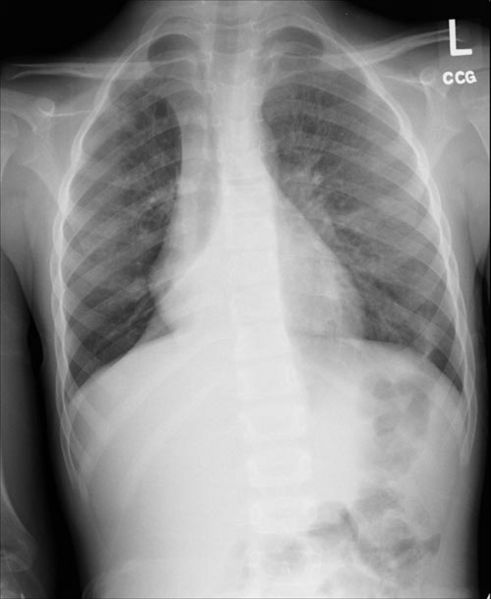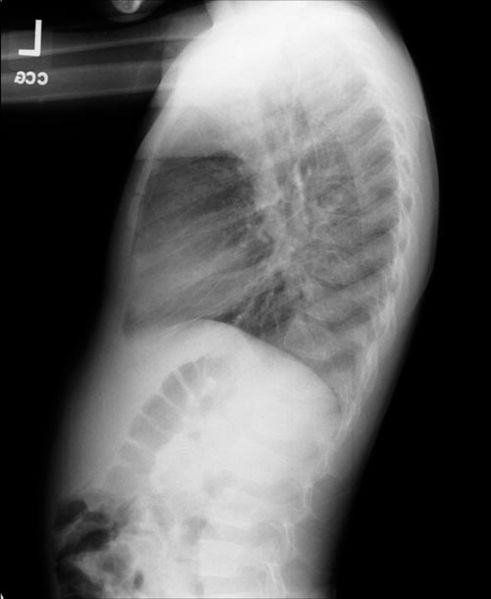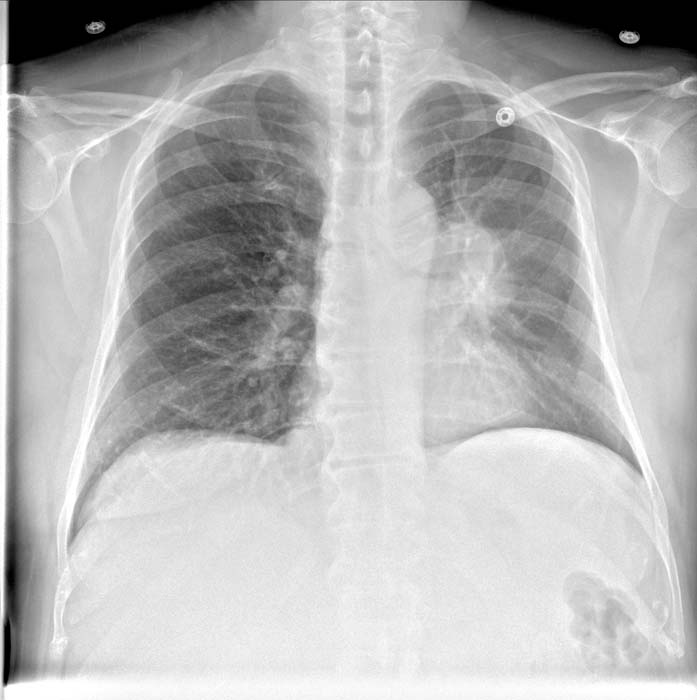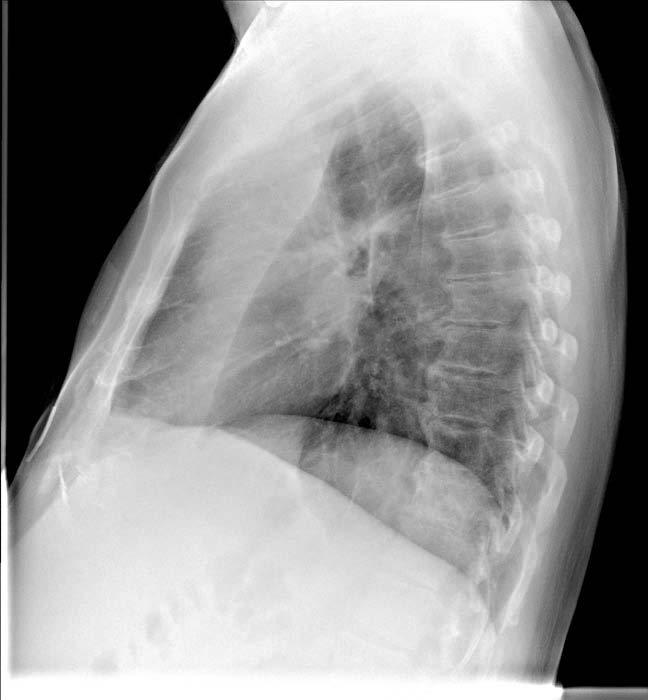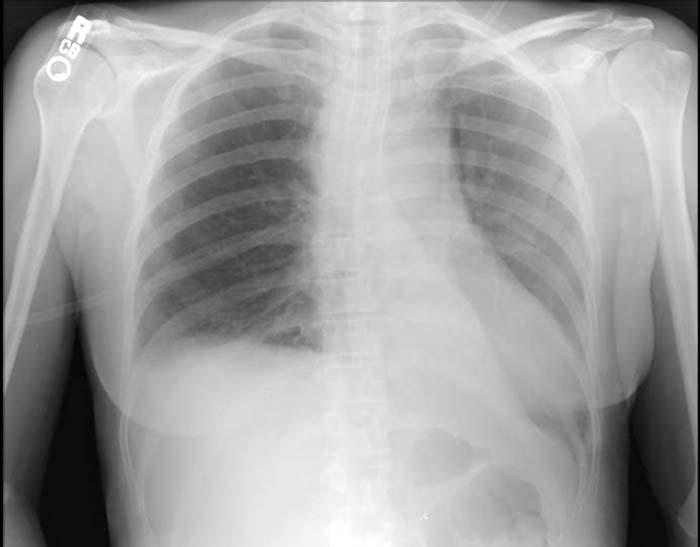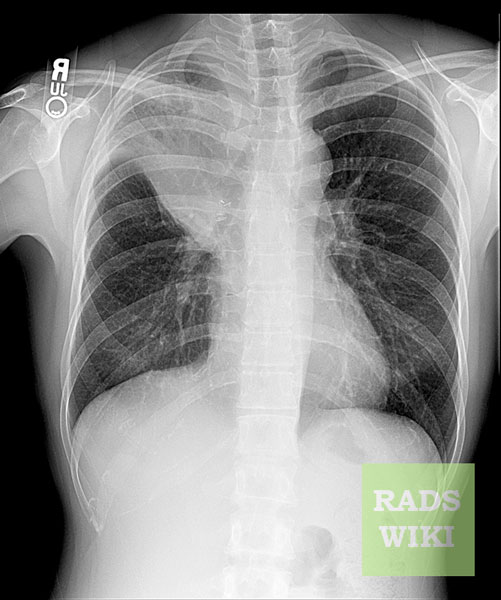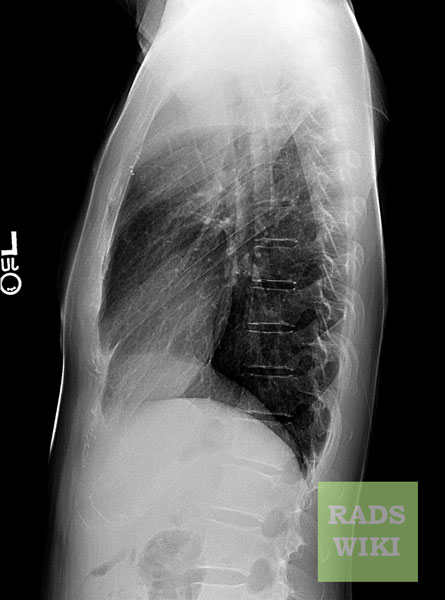Atelectasis chest x ray: Difference between revisions
No edit summary |
No edit summary |
||
| (14 intermediate revisions by 5 users not shown) | |||
| Line 1: | Line 1: | ||
__NOTOC__ | __NOTOC__ | ||
{{Atelectasis}} | {{Atelectasis}} | ||
{{CMG}} | |||
{{CMG}}; {{AE}}{{Cherry}} | |||
==Overview== | ==Overview== | ||
An x-ray may be helpful in the diagnosis of atelectasis. Findings on an x-ray suggestive of atelectasis include [[displacement]] of [[Fissure|fissures]], [[rib]] crowding, elevation of ipsilateral [[Thoracic diaphragm|diaphragm]], volume loss on ipsilateral hemithorax, [[Hilum|hilar]] displacement and compensatory hyperlucency of the remaining lobes. Complete lung atelectasis and atelectasis involving different parts of the lung have their own characteristic appearance. While complete atelectasis of the lung may lead to opacification of the entire hemithorax and ipsilateral shift of the [[mediastinum]], a right midle and lower lobe atelectasis may show [[Pleural effusions|subpulmonic effusions]] along with right [[Thoracic diaphragm|hemidiaphragmatic]] elevation on X-ray. | |||
==X Ray== | |||
*Atelectasis of the lung is a very common abnormality seen on chest radiographs. Abnormalities on chest X-ray due to atelectasis help in the delineation of the underlying pathology.<ref name="pmid11227785">{{cite journal |vauthors=Ashizawa K, Hayashi K, Aso N, Minami K |title=Lobar atelectasis: diagnostic pitfalls on chest radiography |journal=Br J Radiol |volume=74 |issue=877 |pages=89–97 |date=January 2001 |pmid=11227785 |doi=10.1259/bjr.74.877.740089 |url=}}</ref> | |||
*Different types of atelectasis have their own characteristic radiographic pattern and etiology. | |||
*An x-ray may be helpful in the diagnosis of atelectasis. Findings on an x-ray suggestive of atelectasis include:<ref name="pmid16716813">{{cite journal |vauthors=Qureshi NR, Gleeson FV |title=Imaging of pleural disease |journal=Clin. Chest Med. |volume=27 |issue=2 |pages=193–213 |date=June 2006 |pmid=16716813 |doi=10.1016/j.ccm.2006.02.001 |url=}}</ref> | |||
**Signs of lobar collapse such as: | |||
***[[Mediastinal|Shifting of the mediastinum]] towards the collapsed [[Lung|lung lobe]] | |||
***[[Hilum|Hilar]] displacement | |||
***Silhouetting of the [[Thoracic diaphragm|diaphragm]] or the heart border | |||
***[[Rib]] crowding | |||
***Compensatory hyperlucency of the remaining lobes | |||
***Elevation of [[Diaphragm|ipsilateral diaphragm]] | |||
***Opacification of the collapsed lung lobe | |||
***Displacement of [[Fissure|fissures]] | |||
***Volume loss on ipsilateral hemithorax | |||
***Air bronchograms help delineate the site of [[obstruction]] | |||
*X-ray findings in cases with complete atelectasis of the lung include:<ref name="pmid8820022">{{cite journal |vauthors=Woodring JH, Reed JC |title=Radiographic manifestations of lobar atelectasis |journal=J Thorac Imaging |volume=11 |issue=2 |pages=109–44 |date= 1996 |pmid=8820022 |doi= |url=}}</ref><ref name="pmid7394541">{{cite journal |vauthors=Proto AV, Tocino I |title=Radiographic manifestations of lobar collapse |journal=Semin Roentgenol |volume=15 |issue=2 |pages=117–73 |date=April 1980 |pmid=7394541 |doi= |url=}}</ref> | |||
**Opacification of the entire hemithorax due to complete collapse of a lung | |||
**Ipsilateral shift of the [[mediastinum]], that helps distinguish atelectasis from [[pleural effusion]] | |||
*X-ray findings suggestive of right upper lobe (RUL) collapse include: | |||
**Medial and superior shift of RUL | |||
**Sign of Golden S: Concave appearance of minor [[fissure]] | |||
**Right minor [[fissure]] elevation | |||
**Right [[Hilum|hilar]] elevation | |||
*X-ray appearance of right middle lobe collapse: | |||
**Triangular opacity | |||
*X-ray appearance of right lower lobe (RLL) collapse: | |||
**Posterior and inferior shift of RLL due to collapse | |||
**Superior triangle sign: Rightward shift of structures in the superior [[mediastinum]] | |||
**Blurring of the right hemidiaphragm (posterior third) | |||
**Visibility of the major [[fissure]], which is usually not seen | |||
*X-ray appearance of a right middle and lower lobe atelectasis:<ref name="pmid8820023">{{cite journal |vauthors=Stark P, Leung A |title=Effects of lobar atelectasis on the distribution of pleural effusion and pneumothorax |journal=J Thorac Imaging |volume=11 |issue=2 |pages=145–9 |date= 1996 |pmid=8820023 |doi= |url=}}</ref> | |||
**[[Pleural effusion|Subpulmonic effusion]] | |||
**Elevation of the right hemidiaphragm | |||
*X-ray appearance of left upper lobe (LUL) collapse: | |||
**Atelectatic left upper lobe shifts anteriorly and superiorly | |||
**PA view: Faint opacity of the atelectatic lobe in the left upper hemithorax | |||
<div align="left"> | * X-ray appearance of left lower lobe (LLL) collapse: | ||
** Retrocardiac opacity | |||
** Downward displacement of the [[hilum]] | |||
** Aortic-knob sign: Obliteration of the [[aortic arch]] by the [[superior mediastinum]] | |||
** Lateral view: Indistinct appearance of the posterior third of the [[Thoracic diaphragm|diaphragm]] due to opacity | |||
* X-ray appearance of rounded atelectasis: | |||
** Subpleural mass | |||
** Location of rounded atelectasis: Right middle lobe, lower lobes or [[lingula]] | |||
** Comet-tail sign or talon sign: Bronchovascular structures projecting out of the mass toward the [[hilum]], in a swirl appearance | |||
** [[Pleural plaque|Parietal pleural plaque]] | |||
* X-ray appearance of post-surgical atelectasis: | |||
** Bibasal pattern | |||
* CXR also helps determine the efficacy of [[chest physiotherapy]] in [[Patient|patients]] with atelectasis. | |||
Images shown in this section are courtesy of RadsWiki and copylefted.<div align="left"> | |||
<gallery heights="175" widths="175"> | <gallery heights="175" widths="175"> | ||
Image:Right-lower-lobe-collapse-001.jpg|Right lower lobe collapse | Image:Right-lower-lobe-collapse-001.jpg|Right lower lobe collapse | ||
| Line 16: | Line 64: | ||
</gallery> | </gallery> | ||
</div> | </div> | ||
<div align="left"> | <div align="left"> | ||
| Line 25: | Line 71: | ||
</gallery> | </gallery> | ||
</div> | </div> | ||
<div align="left"> | <div align="left"> | ||
| Line 33: | Line 77: | ||
</gallery> | </gallery> | ||
</div> | </div> | ||
<div align="left"> | <div align="left"> | ||
| Line 45: | Line 87: | ||
==References== | ==References== | ||
{{reflist|2}} | {{reflist|2}} | ||
[[Category:Needs content]] | |||
[[Category:Needs overview]] | |||
[[Category:Pulmonology]] | |||
[[Category:Disease]] | |||
[[Category:Radiology]] | |||
{{WH}} | {{WH}} | ||
{{WS}} | {{WS}} | ||
Latest revision as of 16:05, 22 February 2018
|
Atelectasis Microchapters |
|
Diagnosis |
|---|
|
Treatment |
|
Case Studies |
|
Atelectasis chest x ray On the Web |
|
American Roentgen Ray Society Images of Atelectasis chest x ray |
|
Risk calculators and risk factors for Atelectasis chest x ray |
Editor-In-Chief: C. Michael Gibson, M.S., M.D. [1]; Associate Editor(s)-in-Chief: Sudarshana Datta, MD [2]
Overview
An x-ray may be helpful in the diagnosis of atelectasis. Findings on an x-ray suggestive of atelectasis include displacement of fissures, rib crowding, elevation of ipsilateral diaphragm, volume loss on ipsilateral hemithorax, hilar displacement and compensatory hyperlucency of the remaining lobes. Complete lung atelectasis and atelectasis involving different parts of the lung have their own characteristic appearance. While complete atelectasis of the lung may lead to opacification of the entire hemithorax and ipsilateral shift of the mediastinum, a right midle and lower lobe atelectasis may show subpulmonic effusions along with right hemidiaphragmatic elevation on X-ray.
X Ray
- Atelectasis of the lung is a very common abnormality seen on chest radiographs. Abnormalities on chest X-ray due to atelectasis help in the delineation of the underlying pathology.[1]
- Different types of atelectasis have their own characteristic radiographic pattern and etiology.
- An x-ray may be helpful in the diagnosis of atelectasis. Findings on an x-ray suggestive of atelectasis include:[2]
- Signs of lobar collapse such as:
- Shifting of the mediastinum towards the collapsed lung lobe
- Hilar displacement
- Silhouetting of the diaphragm or the heart border
- Rib crowding
- Compensatory hyperlucency of the remaining lobes
- Elevation of ipsilateral diaphragm
- Opacification of the collapsed lung lobe
- Displacement of fissures
- Volume loss on ipsilateral hemithorax
- Air bronchograms help delineate the site of obstruction
- Signs of lobar collapse such as:
- X-ray findings in cases with complete atelectasis of the lung include:[3][4]
- Opacification of the entire hemithorax due to complete collapse of a lung
- Ipsilateral shift of the mediastinum, that helps distinguish atelectasis from pleural effusion
- X-ray findings suggestive of right upper lobe (RUL) collapse include:
- X-ray appearance of right middle lobe collapse:
- Triangular opacity
- X-ray appearance of right lower lobe (RLL) collapse:
- Posterior and inferior shift of RLL due to collapse
- Superior triangle sign: Rightward shift of structures in the superior mediastinum
- Blurring of the right hemidiaphragm (posterior third)
- Visibility of the major fissure, which is usually not seen
- X-ray appearance of a right middle and lower lobe atelectasis:[5]
- Subpulmonic effusion
- Elevation of the right hemidiaphragm
- X-ray appearance of left upper lobe (LUL) collapse:
- Atelectatic left upper lobe shifts anteriorly and superiorly
- PA view: Faint opacity of the atelectatic lobe in the left upper hemithorax
- X-ray appearance of left lower lobe (LLL) collapse:
- Retrocardiac opacity
- Downward displacement of the hilum
- Aortic-knob sign: Obliteration of the aortic arch by the superior mediastinum
- Lateral view: Indistinct appearance of the posterior third of the diaphragm due to opacity
- X-ray appearance of rounded atelectasis:
- Subpleural mass
- Location of rounded atelectasis: Right middle lobe, lower lobes or lingula
- Comet-tail sign or talon sign: Bronchovascular structures projecting out of the mass toward the hilum, in a swirl appearance
- Parietal pleural plaque
- X-ray appearance of post-surgical atelectasis:
- Bibasal pattern
- CXR also helps determine the efficacy of chest physiotherapy in patients with atelectasis.
Images shown in this section are courtesy of RadsWiki and copylefted.
References
- ↑ Ashizawa K, Hayashi K, Aso N, Minami K (January 2001). "Lobar atelectasis: diagnostic pitfalls on chest radiography". Br J Radiol. 74 (877): 89–97. doi:10.1259/bjr.74.877.740089. PMID 11227785.
- ↑ Qureshi NR, Gleeson FV (June 2006). "Imaging of pleural disease". Clin. Chest Med. 27 (2): 193–213. doi:10.1016/j.ccm.2006.02.001. PMID 16716813.
- ↑ Woodring JH, Reed JC (1996). "Radiographic manifestations of lobar atelectasis". J Thorac Imaging. 11 (2): 109–44. PMID 8820022.
- ↑ Proto AV, Tocino I (April 1980). "Radiographic manifestations of lobar collapse". Semin Roentgenol. 15 (2): 117–73. PMID 7394541.
- ↑ Stark P, Leung A (1996). "Effects of lobar atelectasis on the distribution of pleural effusion and pneumothorax". J Thorac Imaging. 11 (2): 145–9. PMID 8820023.
